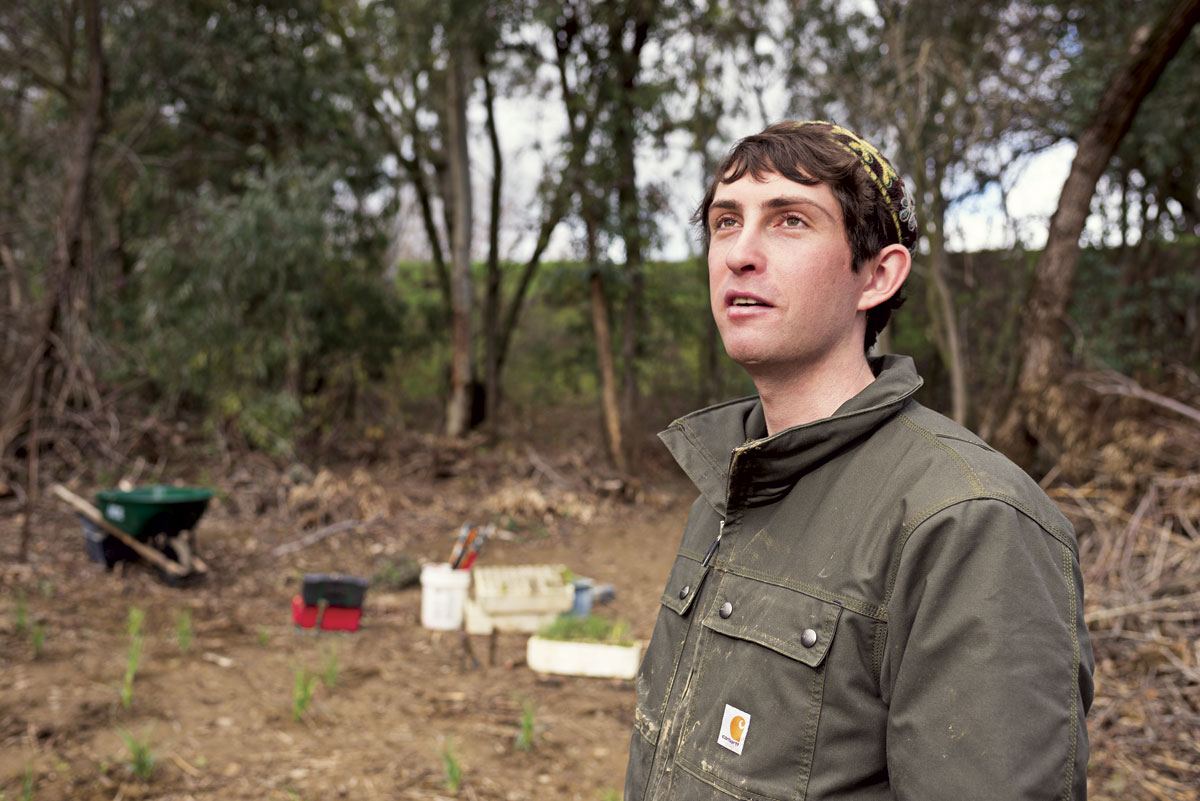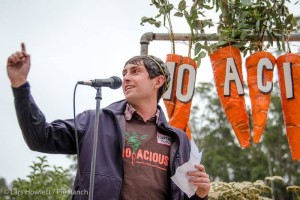A large ripple moving upstream in Putah Creek stops Naftali Moed mid-sentence. Moed, a senior at UC Davis majoring in environmental policy analysis and planning, wants to identify the cause of the wake.
“Might be an otter,” he says. “We have otters and beavers and muskrats.”
On a damp December day, Moed is giving me a tour of the UC Davis Putah Creek Riparian Reserve, a 640-acre section of creek, riparian woodland, public trail, and adjacent grasslands where he has been organizing restoration projects for several years. Moed’s high cheekbones, clear almond eyes, and ears that jut out below his kippah cap reflect his youth, but in word, deed, and thought, this 21 year-old has an understanding of the natural world and how to engage others in its protection that bespeaks maturity beyond his years.
We have just descended a set of steps, leading to a creek bank, that Moed tells me were constructed by a group of volunteers he organized last summer during his internship with the reserve. In the past, he says, the reserve, the UC Davis Putah Creek Council, and the Solano County Water Agency worked on separate projects here. But for this one, Moed brought together interns and volunteers from all three organizations, and they completed the stairway in an hour.
It wasn’t Moed’s first time organizing a stewardship project. “One of the things that Judaism emphasizes that resonates with me is tikkun olam, which translates roughly to ‘repairing the world,’” he says. “Given my interest in nature and love for spending time outside, this is how I engage in that.”
He’s been at it for years. As a student at Oceana High School in Pacifica he volunteered and interned with the Golden Gate National Parks Conservancy and helped start a school garden after several volunteer trips to Pie Ranch in Pescadero.
“I love having a physical connection to land. I learn a lot in the classroom but I learn the most out here where I can watch things unfold,” he says.
When Moed first came to UC Davis three years ago, the bank on which we’re standing was as barren as a beach. Wild rice cutgrass had tried to take hold but was trampled by people and dogs. It was unfortunate, because cutgrass is fantastic cover and habitat for salmon, a biologist told Moed.
“One of [the] main drivers behind restoration on this creek is to get the salmon back,” Moed says. “Over the past 30 years that [UC Davis fish biologist] Peter Moyle has been tracking it, [the creek] has averaged 15 to 30 chinook a year. Last year we had over 200. This year, I think the latest number is 500 individuals in the run, which is an amazing success. The stuff that I’ve worked on has certainly helped, but it’s really Peter Moyle and all these folks who have been doing this work for years. Now the salmon are coming back.”
Moed, as a sophomore, asked the biologist if a stand of alders might serve as a low-cost barrier to minimize the foot traffic and give the cutgrass a chance to grow. The answer was yes, and Moed swung into action.
To get the alders planted, Moed engaged Wild Campus, a conservation group he had joined in his freshman year and for which he served as vice president and president in subsequent years. He mobilized about 50 volunteers to plant 20 alders donated by the Putah Creek Council. Half of those trees have survived and are now 20 feet tall.
As Moed and I admire a healthy swath of cutgrass at the water’s edge, he explains that his moms (he was raised by two lesbian mothers) encouraged him to spend time outside. “I remember going hiking and camping when I was little, and the summer camps I went to…”
That’s when he pauses to watch the ripple.
We both expect to see an otter’s head pop up, but instead we see a fin.
“It’s a chinook salmon,” he says.
“It’s huge!” I say, guessing it to be about 30 inches long.
We watch the fish swimming upstream until it’s out of sight and set out after it.
“There wasn’t one experience or one person that set me on this path,” he continues. “It was a combination of everyone and everything,” he says. “It’s sort of like the alders. Wild Campus got the people out there, and Putah Creek Council donated the trees. Nothing is sustainable in the long run if you don’t bring in different people and groups.”

“I could probably have planted four times as many trees,” Moed says. “But I thought it would be a lot more valuable to bring more people into the work and help raise the level of awareness of the creek by talking to people. I never turn down the opportunity to talk to somebody…You might talk to someone and get them to volunteer, and then they switch majors, and six years later you read about them as the new director for the conservancy. That’s the mentality I have.”
At our last stop on the creek we see more salmon. A battered old fish with fissures on its back and several smaller ones swim in the pool. Two hundred feet downstream, two salmon are flapping their bodies to create a redd (gravel nest) and seem to be spawning. I am tempted to get a closer look, but Moed artfully steers me back to the main trail to let them spawn in peace.
“In outreach and engagement,” he says, “you send emails, talk to a bunch of random people, meet people you otherwise wouldn’t meet and share stuff with them, and then try to bring those people together to get the greatest amount done. It’s also a positive outcome to bring 20 people out here for a walk. Even if nothing physical has been accomplished, hopefully there are 20 fewer people who will set things on fire, tear up the trails with an ATV, hunt illegally, or disturb the spawning salmon.
“I hate the idea of a silver bullet solution, because there generally isn’t one,” he says, stopping to remove several large branches blocking the trail. “It’s like climate change. If you base your understanding of climate change on what’s reported in mainstream news, the narrative would be ‘huge problem, no solution.’” But if you take the time to look at things, you’ll see that there’s a huge array of many different problems and a huge array of infinitely small solutions.”
After graduating this year, Moed plans to work, possibly with land trusts, before heading to graduate school.
At the end of the gravel road, we say good-bye, and he mounts his bike for the ride back to campus.
Celebrate Our Local Heroes
Join us in honoring Bay Nature’s Local Heroes at our 2016 Local Hero Awards Dinner on March 20, 2016 at the UCSF-Mission Bay Conference Center in San Francisco. Click here for more details about the dinner and purchase tickets.
Ticket sales extended through Monday, March 13th!



